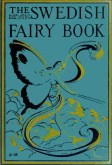The Lady of Pintorp
Swedish folktale
Where to-day a castellate building towers between spreading parks and gardens on the noble estate of Eriksberg, there lay in ancient times a holding known as Pintorp; with which legend has associated the gruesome tale of the lady of Pintorp.
In Pintorp—so the legend says—there dwelt a nobleman who, dying in his youth, left all his goods and gear to his widow. Yet instead of being a kind mistress to her many dependents, she exploited them in every way, and ill-treated them shamefully. Beneath her castle she had deep subterranean dungeons, in which languished many innocent people. She set vicious dogs at children and beggars, and if any one did not come to work at the right time, he was sure to go home in the evening with weals on his back.
Once, early in the morning, when the men came to work, the Lady of Pintorp was standing on the castle steps, and saw a poor farm-hand belonging to the estate come too late. Foaming with rage, she overwhelmed him with abuse and reproaches, and ordered him to chop down the largest oak on the whole estate, and bring it, crown foremost, to the castle court before evening. And if he did not carry out her command to the very letter—so she said—she would drive him from his hut without mercy, and all that he had should fall to the estate.
With heavy thoughts of the severe judgment passed upon him, the farm-hand went to the wood; and there he met an old man who asked him why he was so unhappy.
"Because it is all up with me, if our Lord in His mercy do not help me," sighed the unfortunate man, and told of the task his mistress had imposed on him.
"Do not worry," said the unknown, "Chop down this oak, seat yourself on the trunk, and Erik Gyllenstjerna and Svante Banér will take it to the castle."
The farm hand did as the old man told him, began to hew to the line, and sure enough, at the third stroke the tree fell with a tremendous crash. Then he seated himself on the trunk, facing the crown, and at once the tree began to move, as though drawn by horses. Soon it rushed along so swiftly that posts and garden-palings flew out of the way like splinters, and soon they had reached the castle. At the moment the tree-top struck the castle-gate, one of the invisible bearers stumbled, and a voice was heard saying: "What, are you falling on your knees, Svante?"
The Lady of Pintorp, who was standing on the steps, knew well who was helping the man; yet instead of feeling regret, she began to curse and scold, and finally threatened to imprison the farm-hand.
Then the earth quaked so that the walls of the castle shook, and a black coach, drawn by two black horses, stopped before the castle. A fine gentleman, clad in black, descended from the coach, bowed to the lady and bade her make ready and follow him. Trembling—for she knew well who the stranger must be—she begged for a three years' respite; but the black gentleman would not grant her request. Then she asked for three months, and that he refused as well. Finally she begged for three weeks, and then for three days; but only three minutes were allowed her to put her house in order.
When she saw there was no help for it, she begged that at least her chaplain, her chamber-maid, and her valet be allowed to accompany her. This request was granted, and they entered the carriage. The horses at once started off, and the carriage drove away so swiftly, that the people at the castle saw no more than a black streak.
When the woman and her companions had thus driven a while, they came to a splendid castle, and the gentleman in black led them up the steps. Above, in the great hall, the woman laid off her costly garments and put on a coarse coat and wooden shoes. Then he combed her hair three times, till she could no longer bear it, and danced with her three times until she was exhausted.
After the first dance the Lady begged to be allowed to give her golden ring to her valet, and it burned his finger like fire. After the second dance she gave her chamber-maid her bunch of keys, and that seared the girl's hand like red-hot iron. But after the third dance, a trap-door opened in the floor, and the Lady disappeared in a cloud of smoke and flame.
The chaplain, who was standing nearest her, looked down curiously into the opening into which his mistress had sunk; and a spark shot up from the depths, and flew into his eye, so that he was blind in one eye for the rest of his life.
When it was all over, the black gentleman allowed the servitors to drive home again; but expressly forbade them to look around. They hastily entered the coach, the road was broad and even, and the horses ran rapidly. But when they had gone a while, the chamber-maid could no longer control her curiosity, and looked around. That very minute horses, coach and the road itself were gone, the travellers found themselves in a wild forest, and it cost them three years to get out again, and make their way back to Pintorp.
NOTE
In "The Lady of Pintorp" (Hofberg, p. 157) the devil appears in all his grewsome Satanic majesty. It has been claimed that the evil woman was a historical figure, the wife of the royal counselor Erik Gyllenstjerna.
The Swedish Fairy Book

Notes: Contains 28 Swedish folktales.
Author: Various
Editor: Clara Stroebe
Translator: Frederick H. Martens
Published: 1921
Publisher: Frederick A. Stokes Company